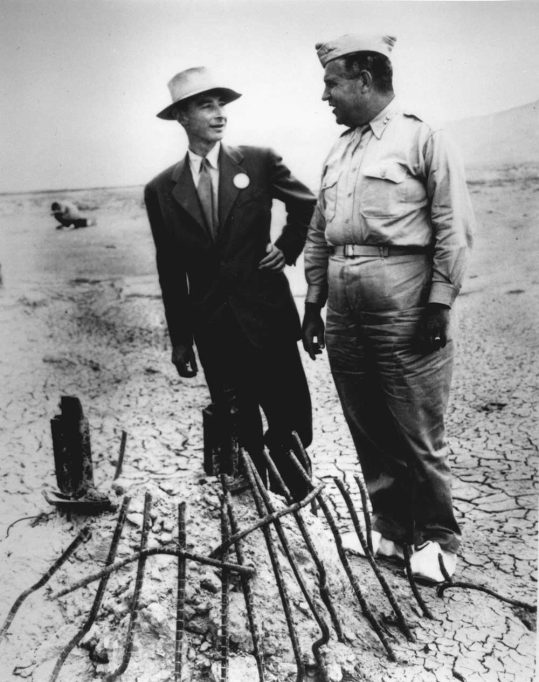
Oppenheimer, the film by American director Christopher Nolan, was undoubtedly one of the year’s blockbusters, thanks in part to an extensive advertising campaign. The film’s release was immediately covered by almost every weekly film magazine and the general media. However, Oppenheimer is not just a biopic or another historical film. On the contrary, it tells the story of a defining moment in World War II and the beginning of the Cold War: the development of the first atomic bomb. It is a relatively unknown subject, barely present on screen, and its inclusion in a blockbuster like Nolan’s film inevitably means that it has now become part of the collective imagination.
Thus, far from being a fleeting entertainment product, a film that details the development of the Manhattan Project to the general public for the first time will surely shape our basic knowledge about the creation of atomic weapons. Very few people will have previous knowledge about the origins of the atomic age before seeing the film, and hardly anyone will look into it after. It will inadvertently become our default primer on the atomic bomb, establishing fundamental ideas and beliefs about its origin and historical role. It is therefore important to raise questions about the film and its plot, beyond its artistic or commercial value. First and foremost, we need to discuss the film’s historical accuracy, and secondly, its treatment of physicist Robert Oppenheimer and the development of the nuclear weapon.
First of all, the historical accuracy of the film is flawed. Although it is almost impossible to turn a true story into commercial fiction without deviating somewhat from the truth, our example does so significantly. In the film, after the bomb is dropped on Hiroshima, Oppenheimer seems to regret his invention. This rhymes with the anguished image he offers as a young man at the beginning of the film. It is interesting that this idea is not verbalised in the film, but is expressed in a vision scene. As the project staff gather to celebrate the successful detonation in Japan, he imagines the effects of the bomb on the bodies of his collaborators as they applaud enthusiastically. The image shows how the scale of the destruction caused by his invention overshadows the glory of the scientist. In fact, throughout his life, Oppenheimer maintained that developing the bomb had been the right decision at the right time. Strictly speaking, the applause scene does not contradict the truth because it does not put false words in the mouth of the protagonist. However, the film uses an aesthetic device to make the character appear more divided and confused than he actually was when the bombs were dropped. It is worth noting that he later became an advocate of nuclear arms control, never of their abolition.

In the picture, Robert Oppenheimer and Leslie Groves, the US military officer who supervised the Manhattan Project, examine the remains of the infrastructure built for the test of the atomic bomb, codenamed «Trinity», on 25 July 1945 in New Mexico. / Digital Photo Archive, Department of Energy (DOE), courtesy of AIP Emilio Segrè Visual Archives
After the detonations of 1945, Oppenheimer argued that nuclear weapons should be placed under the authority of an international agency. This effort is well documented in the contemporary writings of the scientist himself. Unfortunately, it did not come to pass, and the international agency that comes closest to what he proposed is the International Atomic Energy Agency, which is responsible for verifying through inspections that nuclear material from civilian programmes is not diverted for military purposes and that nuclear weapons remain in the hands of their states. The lesson is clear: science can provide rulers with an invention that multiplies their power and influence – in this case by increasing their destructive capacity – but this does not mean that the rulers themselves can ignore the recommendations of creative scientists on how to use the end product. We see this in the meeting between Oppenheimer and the American President Truman, who, in a true-to-life scene, rejects the physicist and then asks his secretary to avoid meeting him in the future.
The film also narrates how the protagonist’s political aspirations are cut short because of his old association with members of the Communist Party present in the university environment. At the time of the «witch hunt», this was reason enough to revoke the security clearance that gave the physicist access to government circles. Indeed, this is highlighted in the book American Prometheus, which the film is based on. The book’s title compares the figure of Oppenheimer to the Greek titan who brought fire to humankind and provoked the wrath of the gods. The graphic depictions of his Olympian punishment, which consisted of his entrails being eaten by crows for eternity, still induce nausea in the best museums in the world.
Which brings us to the next question. What influence does the choice of this episode in Oppenheimer’s life have on our perception of the creation of nuclear weapons? It is not one to be ignored. First of all, the portrayal of the scientist as a pariah because of his contacts with Communists who never posed a threat to American military secrets turns him into an unfairly treated victim. In reality, the revocation of his security clearance was a minor punishment that only frustrated the physicist’s political ambitions, not his scientific career. Very few civilians have such clearances, and of course many victims of the witch hunt suffered far more serious consequences than the revocation of a permit. But most important (and least appropriate) is the comparison underlying the story, which suggests that the brilliant scientist was punished (again unfairly) after delivering the atomic weapon to humanity, rather than receiving the recognition of the nation. The analogy with Prometheus, together with the way the plot is structured around the investigation of his case by the American authorities, makes the protagonist seem like the victim of a prejudiced, ungrateful society.
How does such a narrative affect our defence of nuclear weapons? The emphasis on the injustice suffered by the protagonist and the absence of a confrontation with the consequences of his project during the Cold War leaves the most important question in Oppenheimer’s story unresolved: the responsibility of the scientist with regard to his discoveries and inventions. The physicist concluded his project after the capitulation of Germany, whose defeat had motivated the development of the atomic weapon. In other words, he completed his project when it was no longer needed: its use against Japan became the only viable alternative. Meanwhile, ethical considerations about the scale of the lasting devastation that the atomic bomb could – and did – cause do not seem to have been an obstacle to its development. Indeed, Oppenheimer would later express concern about the proliferation of nuclear weapons, as well as the construction of the hydrogen bomb, many times more destructive than the bombs used in World War II and in existence since the 1960s.
The central lesson of Oppenheimer’s experience may have less to do with the dichotomy between punishment and general praise articulated by Nolan, and more to do with the fact that once the genie is out of the bottle, there is no going back. Anticipating the consequences before acting is part of the scientist’s responsibility to society. After all, if we have not seen a nuclear attack on a civilian population since 1945, it is thanks to the invention of arms control and, to a lesser extent, luck. And the story of the nuclear arms race, which was reversed in the 1990s, is not over. Perhaps it is only paused now, in view of the gradual dismantling of the framework that regulates it. From the point of view of the social sciences – and above all of teachers who want to show the film in the classroom – Nolan’s work must be treated with care: it can be used as teaching material, but always accompanied by a debate with the students about the dangers of fictionalising historical events and the responsibility of scientists for their actions, especially when they conflict with national service or personal ambition.





